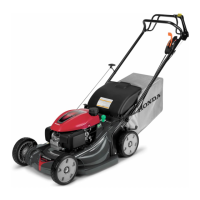2-12
SERVICE INFORMATION HRX217HYA • HRX217HZA
8. TROUBLESHOOTING TECHNIQUES
COMPRESSION TEST
1. Start the engine and warm up to normal operating
temperature.
2. Turn the fuel valve lever to the OFF position, and then drain
the fuel from the carburetor.
3. Remove the spark plug cap from the spark plug.
4. Remove the spark plug using a spark plug wrench.
5. Pull the recoil starter several times to expel unburned fuel.
6. Attach a commercially available compression gauge into the
spark plug hole.
7. Briskly pull the recoil starter repeatedly to measure stable
cylinder compression. Do not use the electric starter to
perform the compression test.
SPARK PLUG TEST
An assistant is required during this test.
1. Turn the fuel valve lever to the OFF position, and then drain
the gasoline from the carburetor.
2. Disconnect the spark plug cap from the spark plug.
3. Remove the spark plug using a spark plug wrench.
4. Pull the recoil starter several times to expel unburned
gasoline.
5. Attach the spark plug to the spark plug cap, and ground the
side electrode against the cylinder head bolt.
6. Have an assistant briskly pull the recoil starter several times
for you.
7. Check to see if sparks jump across the electrodes.
CYLINDER COMPRESSION:
0.50 MPa (5.1 kgf/cm
2
, 73 psi) / 600 rpm
WARNING
Gasoline is highly flammable and explosive. If ignited,
gasoline can burn you severely.
Before testing the spark plug:
• Be sure there is no spilled fuel near the engine.
• Place the spark plug away from the spark plug
hole.
COMPRESSION GAUGE
EEPV503 (commercially available)
SPARK PLUG CAP
SPARK PLUG
HEAD COVER BOLT

